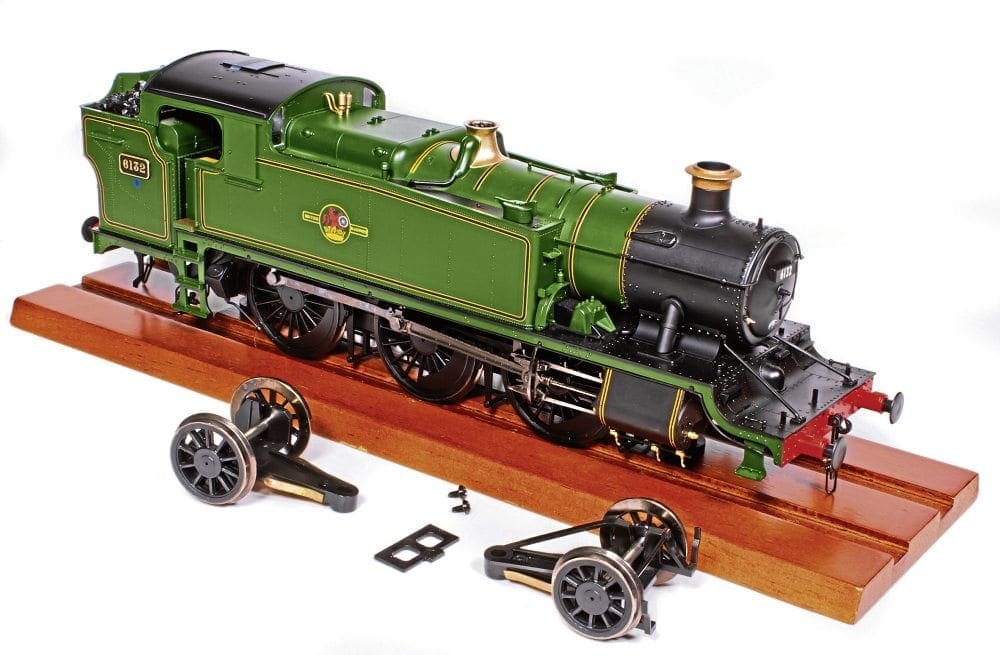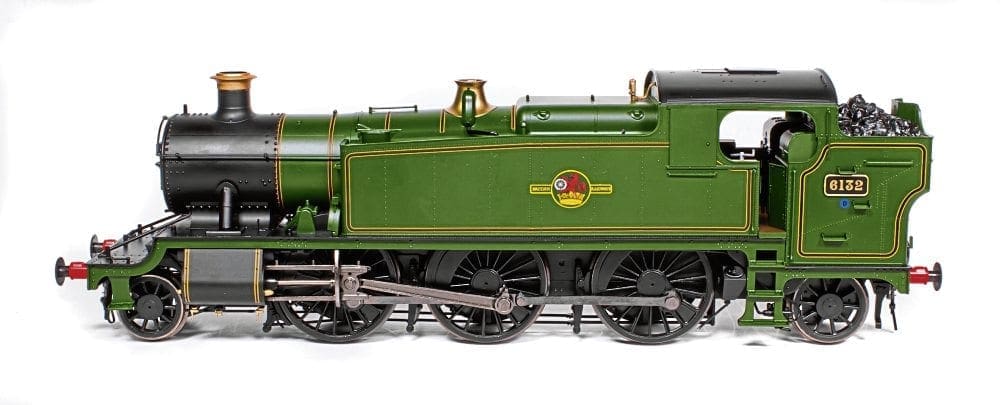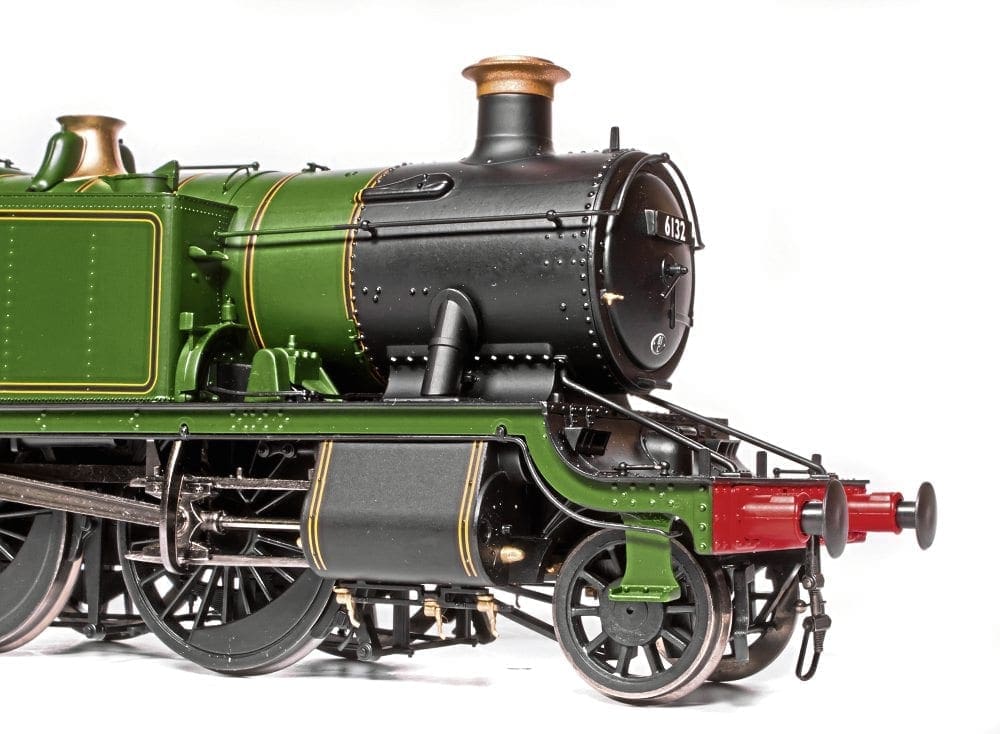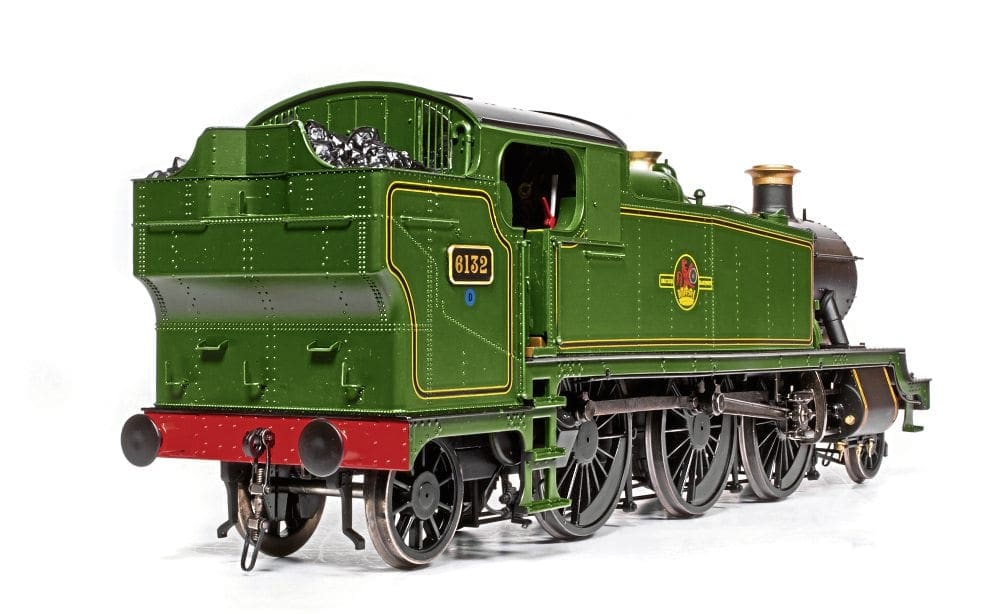Heljan’s first O-gauge steam locomotive model is of a successful tank locomotive design by Charles Collett that dominated suburban services from Paddington for more than 20 years.
The GWR ‘61XX’ Class 2-6-2T, referred to as the ‘Large Prairie’, evolved from the GWR ‘5101’ type, itself a development of the 31XX Class that had been successful in suburban traffic. Constructed between 1931 and 1935, the powerful 61XX Class tank locomotives could run at speed in both directions. A 225 psi boiler pressure, combined with medium-sized driving wheels, gave the locomotives good acceleration and sufficiently high tractive effort to lift heavily-loaded suburban services with tight timings.
A total of 70 61XX Class locomotives, numbered 6100-6169, were constructed at Swindon Works between 1931 and 1935. They were fitted with trip-cock equipment for working LT lines and (either from new or as a retrospective installation) GWR Automatic Train Control. Allocations included Old Oak Common, Slough and Aylesbury until the ‘Large Prairies’ were displaced by Class 117 and 121 DMUs from 1959. By the late 1950s, the writing was on the wall for the class, and withdrawals began in 1958. The locomotives’ roles were diminished to freight and parcels duties in the early 1960s, together with some branch working, until total withdrawal at the end of steam in 1965.
One 61XX Class locomotive, No. 6106, has been preserved and is on static display at the Didcot Railway Centre.
Body moulding
First impressions are important, and the initial one is of a well constructed model that matches published photographs of the full-size locomotives well. The proportions look good, and the character of these hard-worked suburban locomotives has been beautifully crafted in O gauge by Heljan. A closer look reveals a high level of subtly-executed moulded detail on the body sections, including the rivet detail, the line of the tapered boiler, with its fine boiler bands, and the distinctive shape of the firebox top.
The prototypical gap under the boiler behind the smoke box saddle is present as are the (cosmetic) sliding cab side screens. The cab roof ventilator slides open, allowing it to be posed to suit the use of the model.

Fine details
In addition to the neat assembly of the main body components, there is a wealth of separate fittings too numerous to list individually. From larger parts such as the chimney and dome through to the whistles, a tiny smoke box steam lance and the darts themselves, the model is covered with detail which gives it an exceptional appearance.
Everything, including handrails and the larger fittings such as water tank lids, are all neatly applied with no sign of glue marks, and all are correctly seated. The number plates are plastic mouldings fitted to the bunker sides with printed numerals instead of the raised ones found on the prototype, but it is easy to pry them off the model and replace them with etched brass number plates.
Cab interior
Fine detailing is extended to the cab interior, which is decorated with pressure gauges, water gauges, levers and controls, all picked out in copper, brass and the appropriate colours for the driving controls. A brake stand and reversing lever are visible on the inside of the cab sides while the doors are fixed, one in the open position. They are fitted as separate mouldings which, with a little time at the workbench, could be detached, refitted and possibly hinged too, such is the modelling scope offered by O gauge. The cab floor is planked and ready for some coal dust, grime, oil and other weathering effects!

Below the running plate
Fine detailing does not stop at the body of the model, with brake gear and its rigging faithfully represented, and the brake blocks in line with the finely-modelled wheels. A quick check with photographs shows that the wheels are accurate, even though the tyres appear a little on the slim side. The motion is well made from metal parts and sturdy, with workbench running tests demonstrating its smooth action without any catching.
The front and rear bogies are not fitted to the model from new, for there’s little room to accommodate them in the box with the model mounted on its packing plinth, but once the model was removed from its plinth, the bogie wheel assembly with guard irons was fitted to the front of the locomotive, and the one with the larger diameter wheel to the rear. A cross-head screwdriver is required to complete preparations for operation.
Completing the picture are sprung buffers with plastic heads that depress only part way, and very fine factory-fitted screw couplings which have a tiny screw thread allowing them to be adjusted for length with the tommy bar, in the same manner as the real thing. Brake hoses are supplied in the detailing pack for the modeller to fit.
Electronic
A five-pole motor with a single flywheel sits at the heart of this model, which is a good start when replicating the haulage power of the full-size 61XX Class. An ESU-compatible decoder adaptor is fitted and it has a blanking plug fitted for conventional 12v dc operation. The socket will accept a plug and play ESU Loksound L4.0 decoder for digital sound.
A speaker chamber is fitted to the chassis to make digital sound installation easier to complete.
Hard wiring to the ESU interface adaptor is the only way of fitting a different brand of decoder to the model. Current collection is through wiper pick-ups acting on the rear of the wheels which supplies power to the circuit board. Only one lighting circuit is fitted which powers the fire box flicker effect. This is controlled through function F3 when a decoder is installed.

Performance
Tipping the scales at 1625g, and with six driving wheels, the model has impressive tractive effort for its size and is capable of managing six suburban coaches with ease. The instructions caution
the modeller as to the importance of good running-in practices before placing the model under load and subjecting it to full power. The review model ran smoothly and without any sign of binding in both directions, there being little difference in the performance when running in reverse compared to the forward direction.
Finish
The review model is decorated in lined BR green as No 6132, and very smart it looks too. The BR green finish is very good, with sharp lining that’s well executed with no sign of fuzzy edges. This sharp lining is apparent on the boiler bands and the cylinders too. The finish is eggshell – not totally dull, but with a slight sheen which, together with the copper and brass fittings, makes for an attractive model. Small details are picked out in appropriate colours, including the copper chimney cap, whistles and drain cocks. Colouring of all the individual parts is consistent, with no part finished in an obviously different shade.

Overall
Given that OO-gauge modellers are expected to pay between £75 and £89 for limited run wagons these days, the £699 price tag attached to Heljan’s ‘Large Prairie’ looks very good value for money considering the high level of detail, the care in which the model is packed for transport and the excellent running qualities. One point I would make, though, is in regard to the service sheet supplied with the model. A high-end O-gauge model like this one deserves better than the folded A4 sheet with pictures a tad too small to see clearly how to dismantle the model for decoder installation and maintenance.
While this does not detract from the model itself, a quality booklet with clear graphics and pictures would do much to enhance the feel of a really high-quality package which has already created a good impression with its well-designed box and varnished wooden packing plinth. Nonetheless, take good care of the model, together with its packaging and instruction sheet, and there is no reason why it cannot prove to be a good investment and fun at the same time.





